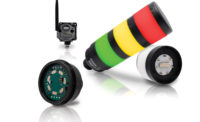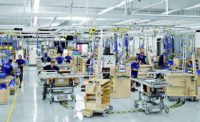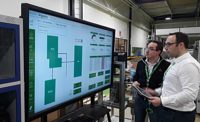How IoT Can Lead to Safer Manufacturing
IoT-enabled devices can alert management to worker fatigue, strain or risk-taking behavior.








The Internet of Things (IoT) continues to evolve at a rapid pace. Businesses of all shapes and sizes, including manufacturers, are taking advantage of the technology’s ability to network, collect, share and act on data from their operations and their customers. The technology has been a cultural and economic boon to consumers, too. Households are increasingly deploying web-enabled thermostats, security cameras with mobile access, and door locks with virtual encryption.
In manufacturing, one of the most common applications of IoT technology is maintenance and equipment monitoring. Computer imaging and wearable devices are helping manufacturers solve their most disruptive business problems. For example, some manufacturers are using IoT sensors on machines to help pinpoint a failure or breakdown. These sensors can also be used for predictive maintenance, sending an alert to the supervisor when a machine on the plant floor needs servicing. By moving away from a regular maintenance schedule, manufacturers can increase uptime and lower costs.
Manufacturers are also using IoT technology to reduce risk in the workplace, whether it be to people, plants or equipment. For example, workers can be equipped with sensors, RFID tags, smart watches and other “wearables” to help reduce the risk of injury, improve worker safety, and lower workers’ compensation insurance claims.
IoT technology can also be deployed to prevent water damage. Sensors can send an alert when moisture is detected in an area that should be dry. This could indicate a plumbing leak. Sensors can be set up to monitor water temperature, humidity and flow. These sensors can trigger automatic shut offs of water control valves to reduce the risk of property damage and business interruption from accidental water events. The most sophisticated systems employ acoustical water flow sensors to take continuous sound measurements from water pipes. Machine learning is then used to transform those signals into water flow estimates and “signatures.” This data can enable engineers to monitor water usage in a way that can predict unwanted incidents.
Industrial IoT and Imaging
Many manufacturing facilities already use cameras in the workplace. IoT imaging software connects to existing cameras. It uses computer vision to identify safety risks and can trigger real-time alerts of unsafe behavior.
Cameras with artificial intelligence software can also help improve compliance with safety protocols, such as wearing safety equipment like vests, gloves and glasses; abiding by forklift zones and speed limits; ensuring proper clean up to prevent slip and fall accidents; and improving ergonomics.
Imaging can also be used to identify incidents as they happen, including slips and falls.
Wearables and Smart Manufacturing
It has become common for people to use wearable technology, such as fitness trackers, to manage their overall health and well-being goals. However, in manufacturing, engineers are increasingly deploying wearable technology to improve ergonomics, track employee location during a crisis, and detect falls. Examples include belts that track movement in the workplace and vests that monitor environmental conditions, air quality and noise levels.
Gloves that record data on how workers use their hands and wrists on the job can help improve worker safety. Armbands that track how often a worker is pushing or pulling repetitively for their work can help reduce job-related injuries. And, straps worn around the chest or other body part can monitor ergonomic issues or detect worker falls.
IoT Innovation Lab
The Hartford’s IoT Innovation Lab sees connected devices as an opportunity to reduce potential insurance losses. It can also raise awareness around safety risks in manufacturing workplaces. The lab’s team uses these devices to predict and prevent losses and provide valuable insights to customers.
For example, a window assembly and warehousing business located in Kansas implemented a wearables IoT program from The Hartford and turned the data collected by the devices into actionable improvements to increase employee safety and benefits for customers.
Wearable devices were able to provide valuable insights on some problematic behaviors of employees, specifically around bending, reaching and twisting. The data brought to light specific habits of employees that could be addressed and solved. The common theme was that sometimes just one small and simple fix can lead to big improvements for employee safety. Seeing the impact to employees through the data was crucial in creating a safety culture and driving change to reduce risk.
Looking for a reprint of this article?
From high-res PDFs to custom plaques, order your copy today!










